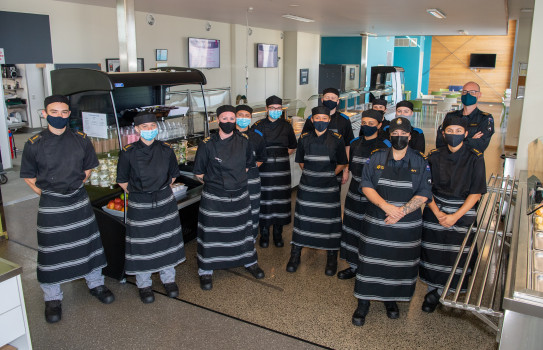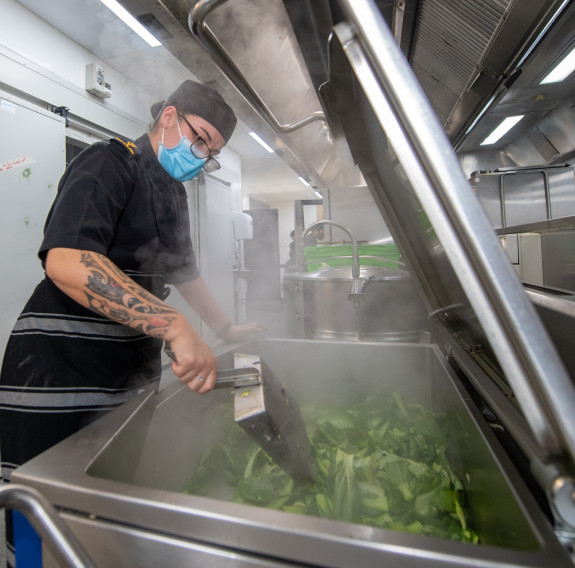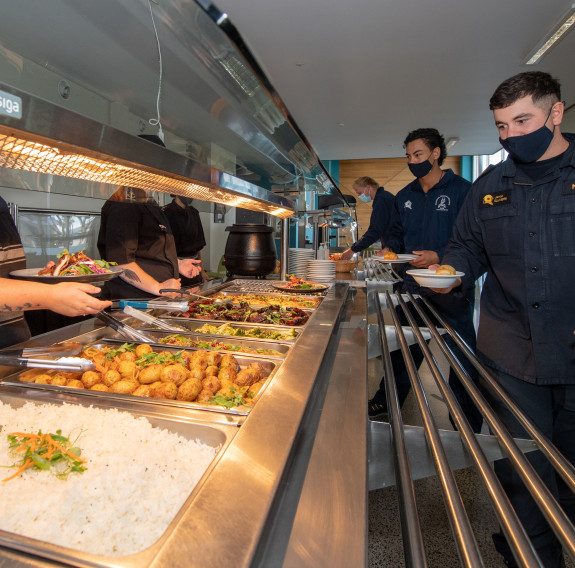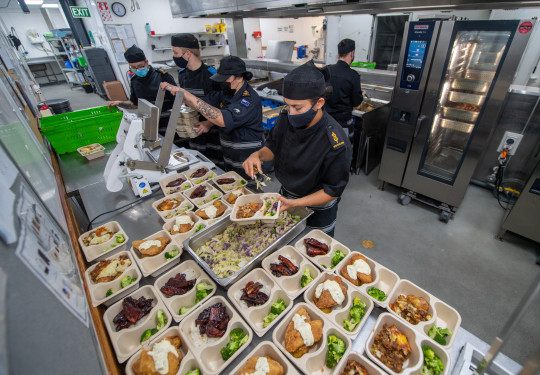The Vince McGlone Galley
It might be a 14-hour day, but there’s a lot of noise coming from the Royal New Zealand Navy's Vince McGlone Galley’s back-of-house section. Loud music, talk and laughter – you can tell the chefs and stewards are happy and pumping.
27 June, 2022
The Vince McGlone Galley is something like a homeport, says Petty Officer Chef (POCH) Jordan Rippey. If you’re not at sea, you’re likely to be there.
It’s also likely to be the first outing for a Navy chef who has finished both their Basic Common Training and Branch (Trade) training, and chefs will return to the Galley when they complete a ship posting. The Galley is the principal dining establishment for Devonport Naval Base and, with the Officer’s Wardroom dining area, is run by Navy chefs. Civilian contractors ESS run the dining halls at the North Yard, mainly for recruits, the Officer Training School at Narrow Neck and the Tamaki Leadership Centre at Whangaparaoa Peninsula.
The Galley provides a lot of stability for the chef trade. It’s a meeting place where chefs will pop in and say hi and spin a yarn or two about their adventures. There’s plenty of experience there, with a Petty Officer running a watch bill and doing the office work, ‘killicks’ (Leading Chefs) working with Able Chefs, Ordinary Chefs and people who have just completed their branch training. It’s a great place to get some serious skills before posting to a ship.

Navy Chefs of the Vince McGlone Galley
COVID-19, and the demands of Operation Protect – NZDF’s support to the Managed Isolation and Quarantine Facilities (MIQFs) – had a huge impact on the routine. No one could collectively dine at the Galley during the intense periods of the COVID pandemic. “Navy chefs are very good,” says POCH Rippey. “We went from producing some of the best meals in the Defence Force, to preparing takeaway meals. When we created an Isolation Facility at Narrow Neck, we’d take up 85 meals. At one point, we were providing up to 18 people to Operation Protect, because we were one of the larger units on base.
“We’d have people coming out of branch training, armed with their task book, and being pinched straightaway to help manage a MIQF.” POCH Rippey organised the galley into three ‘bubble watches’, where teams worked independently of each other in a shift of one 14-hour day, then two days off. If someone got sick with COVID, it wouldn’t affect the other teams. It’s a task-focused routine that has been going for 18 months, with lots of rules about social distancing and hygiene.
“It’s great for the galley to see all these people coming back,” says POCH Rippey, referring to the decommissioning of the Operation Protect Task Force last month. At the moment the team are continuing the 0525 to 1900 shift, but POCH Rippey likes the idea of getting back into more training. Last month the galley opened up to walk-in dining again.
‘Plating up’ experience, when the presentation of a plated meal is taught, is normally an Officers’ Wardroom skill, but the wardroom has been closed during the pandemic.
So in the Galley, there’s a plated dish every lunch. “As a rule, you have three meat dishes and one is plated. The chefs come up with a sauce, a garnish, a salad and a side. It’s something we thought we could do here. It’s not on a grand scale – you don’t want to be plating up 400 meals. And in the afternoon, if there’s time, they’ll practise dishes, and killicks will assist with that.”

Preparing for the lunchtime rush.

Lunchtime service in the Vince McGlone Galley.
It’s not fun if you don’t keep things creative, he says. “A high-performing team is happy when they are pumping out the best food they can. Essentially, I write the menu, get the food in, but the youngsters will say, I really want to try this technique.” There are some traditional crowd-pleasers; Friday is normally a little more relaxed on the nutritional side, where people tend to expect burgers and chips, but you can’t simply put cheese on everything, he says.
“Our chefs consider the portion sizes, the nutritional value. You could do boiled potatoes and pork chops and meet those values, but our chefs have to be creative. It means when they stand behind the slide, they can be proud of what they do. At sea, you’ve got to be careful you don’t run out of food. But here, they can go the extra mile.”
A new feature of the COVID era, particularly with the drain of personnel to MIQFs, is bringing in Stewards to work as chefs. At Devonport Naval Base, stewards would normally ply their trade in the Officers’ Wardroom.
We trained the stewards, who had no real hands-on experience, and they amalgamated beautifully as caterers. They do everything – prepping food, taking charge, getting the food cooked. They have stepped into every single role. It’s not their trade, and not what they are trained to do, and it’s a lot to ask of them. But they have done really really well.
When things are going well, you know it. “The music will be so loud, sometimes I have to tell them to turn it down when the service is on. Everyone is laughing, everyone is talking, it’s an awesome atmosphere. You know it’s at its best when it gets hard, when chefs attack it with a good attitude. Chefs are happiest when they are pumping it out.”
